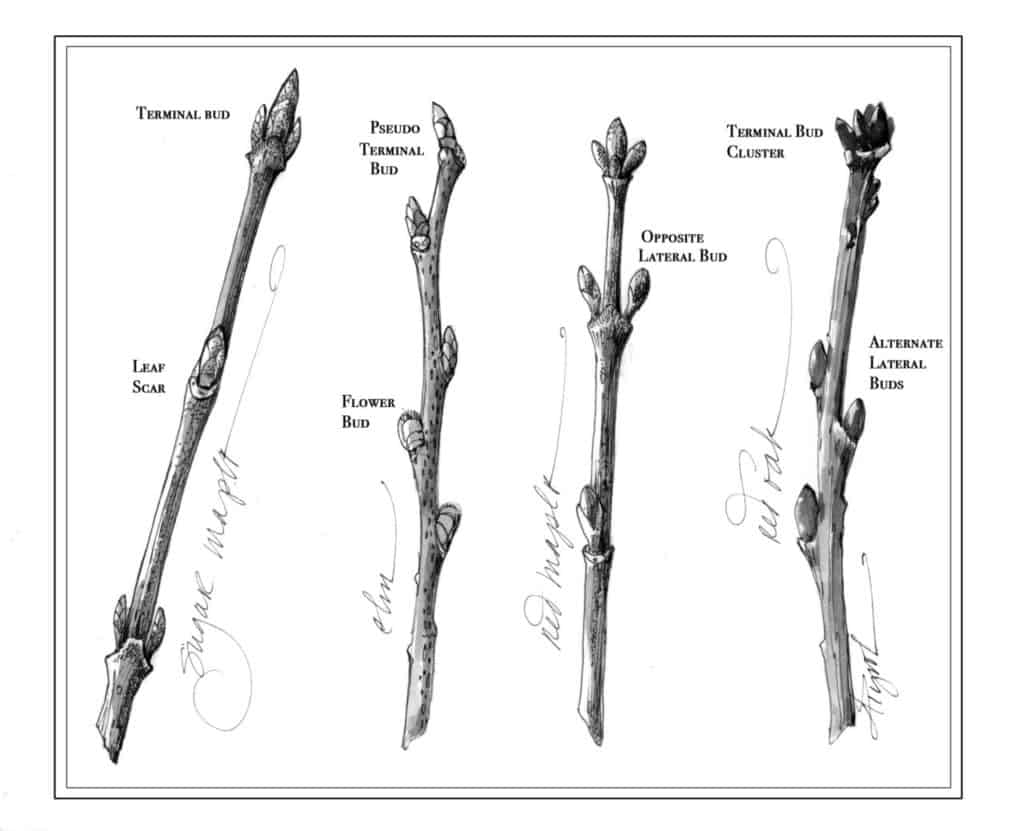
By Susan Shea
The bare branches of the trees outside my window seem lifeless in late winter. However, each twig holds many buds — small, wrapped packages of potential awaiting the spring. These buds formed last summer and are designed to withstand snow, ice, and subzero temperatures. By withdrawing water from them before winter, deciduous trees protect their buds from frost damage.
If you slice open a bud and use a magnifier, you can see tiny green leaves and flowers folded up inside. Some trees have separate buds for leaves and flowers so they can open at different times, while in other species, flowers and leaves are contained within the same bud. According to Vermont biologist and author Bernd Heinrich in his books “Winter World” and “Trees in my Forest,” pre-formed buds enable trees to begin growing quickly in spring, allowing them to make the most of a short growing season.
Most trees, such as sugar maple, have a terminal bud at the end of each twig; this will become the leader of the branch. Lateral buds on the sides of the stem will grow as side branches. A tree’s first priority, explains Heinrich, is growth at the apex to reach sunlight. So the terminal bud releases a growth hormone that stimulates elongation of the main shoot and inhibits growth of the buds below. Heinrich found the leading shoots of several deciduous trees in Maine had already grown 6 inches by late May, while most of the lateral buds had not yet opened.
In trees without a true terminal bud, such as basswood, the lateral bud closest to the end of the twig — called a pseudoterminal bud — will grow the branch leader. Most deciduous tree buds have overlapping scales to protect the delicate leaves and flowers inside. Some, however, like bitternut hickory, have naked buds; instead of bud scales, the outermost pair of leaves is thick and waterproof and completely encloses the inner leaves.
Buds come in a diversity of colors, shapes, and sizes. With practice and the help of a field guide, you can identify trees in winter by examining their buds, as well as the arrangement of buds on the stem. In some species, such as sugar and red maple, the lateral buds are paired and opposite each other on the twig. In others, such as elm, the side buds occur singly as they spiral up the stem — a pattern called alternate branching. The leaf scar located below the winter bud – where the leaf fell off in autumn – varies in size and shape and is another identifying characteristic.
Looking at all of these features together makes it relatively easy to identify most deciduous trees in winter. For example, the sugar maple has a sharp, pointed terminal bud with many scales. Its lateral buds are opposite and leaf scars are V-shaped. Red oaks have a cluster of buds at the ends of their branches: a terminal bud with many scales accompanied by two or three slightly smaller laterals. The other lateral buds alternate up the stem. The butternut tree, which has an alternate branching pattern, sports a large, fuzzy, cream-colored terminal bud and conspicuous leaf scars, which include U-shaped bundle scars. The bundle scars are the sealed ends of tiny tubes through which sap passed from branch to leaf last year.
Many species of wildlife eat leaf and flower buds, which are packed with nutrition. Aspen and birch buds are a mainstay of the winter diet for ruffed grouse. Moose and deer browse on the large buds of striped and red maples as well of those of other trees and shrubs. Snowshoe hares, squirrels, turkeys, purple finches, pine grosbeaks, and other animals also consume winter buds.
Trees respond to a combination of cues that tell them the right time to pump water into their buds to awaken them in spring: day length, duration of cold exposure, and temperature. However, recent studies have found that bud burst in many short-lived, pioneer species, such as gray birch and staghorn sumac, is controlled by temperature only. In these species, periods of extremely warm winter weather can spark bud growth, exposing the tree or shrub to later frost damage – a potential threat in an era of climate change.
Susan Shea is a naturalist, writer, and conservationist who lives in Brookfield, Vermont. Illustration by Adelaide Murphy Tyrol. The Outside Story is assigned and edited by Northern Woodlands magazine and sponsored by the Wellborn Ecology Fund of the New Hampshire Charitable Foundation: nhcf.org.




